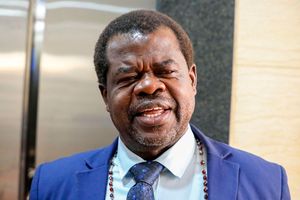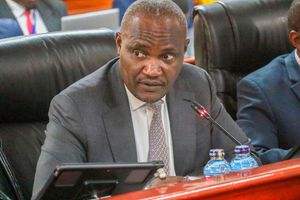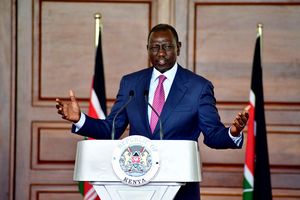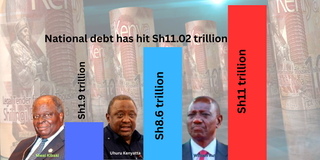
The national debt has hit Sh11.02 trillion.
By the time the sun goes down today, Kenya will have ceded Sh5.1 billion to debts. That will also happen tomorrow, the next day and the day after that.
In the current financial year, Kenya will spend 1.866 trillion on servicing loans. That means Sh5.1 billion for each day of the year.
In the same fiscal year, the Ministry of Health has spent Sh127 billion. That means the amount going to debt repayments each day, could fund the Health ministry for two weeks.
The national debt has grown to Sh11.02 trillion.
For President William Ruto, back from China with promises of fresh economic support, including multiple infrastructure developments like extension of the standard gauge railway (SGR) to Malaba, the stakes are high.
His last budget crashed and burned amid public outrage.
Now, with debts maturing, an impatient populace demanding services, and a new International Monetary Fund (IMF) programme in the works, President Ruto faces an economic tightrope that could define his presidency—and Kenya’s future.
Kenya’s debt saga is a tale of ambition gone awry.
When Mwai Kibaki completed his last term in 2013, the country owed Sh1.894 trillion, which at the time equated to 51.7 per cent of Kenya’s Gross Domestic Product (GDP)—the monetary value of goods and services produced within Kenya’s borders.
Kibaki borrowed modestly, channelling funds into roads like the Thika superhighway, which jolted rural economies. Daily debt servicing averaged Sh400 million. It was manageable.
Enter Uhuru Kenyatta.
Through his decade in power, Kenya borrowed Sh6.7 trillion—nearly five times Kibaki’s total. By 2022, daily debt servicing had soared to Sh2.1 billion.
President Ruto’s administration, grappling with a weakening shilling and inherited burdens, now has to fork out an average of Sh3 billion daily. Defaulting such debt would throw Kenya into the abyss.
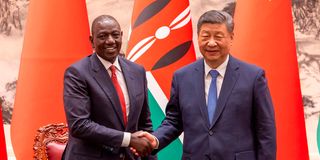
President William Ruto with his Chinese counterpart Xi Jinping at the Great Hall of the People in Beijing, China.
The debt-to-GDP ratio, a key measure of economic health, sits at 65.6 per cent—well above the IMF’s 40 per cent comfort zone for emerging economies like Kenya.
“We became reckless between 2014 and 2019,” Treasury Cabinet Secretary John Mbadi told Family TV last Friday. “A lot of the borrowing was very expensive.”
Spend Sh1.8 trillion
Expensive, indeed. In the financial year ending June 2025, Kenya will spend Sh1.8 trillion on debt—over half its budget—leaving provision for schools, hospitals and roads stretched thin.
Exhibit A in Kenya’s borrowing binge is the SGR. Launched in 2014 with a $3.23 billion (Sh327 billion at the time) loan from China’s Exim Bank, the SGR promised to stitch East Africa together, slashing transport costs from Mombasa to Nairobi and beyond.
Four presidents—Uhuru Kenyatta, Uganda’s Yoweri Museveni, Rwanda’s Paul Kagame and South Sudan’s Salva Kiir, along with Chinese Prime Minister Li Keqiang—cheered the vision.
They gathered at State House Nairobi for the signing of the one-of-its-kind railway project that would connect the four East African states and significantly reduce the cost of moving goods and improve efficiency.
But Uganda’s 2018 withdrawal—citing Kenya’s delays—left the railway dream marooned. Now, it costs $439 million (Sh56.85 billion at current exchange rates) yearly to maintain, a burden economist Kwame Owino calls a “free-fall”.
Mr Owino, the CEO of the Institute of Economic affairs, argues that Kenya should have tamed the borrowing beast early. Instead, the SGR stands as a monument to unchecked optimism.
If the SGR is a misadventure, the Eurobond saga is a scandal.
In 2014, Kenya raised $2.75 billion (Sh280 billion at the time) through its first Eurobond for infrastructure.
Auditor-General Edward Ouko’s probe found the funds untraceable, mixed up with government cash.
“The special audit, therefore, confirmed that the Eurobond proceeds were received, and were fungible, at the National Exchequer Accounts in Central Bank of Kenya and are, therefore, not identifiable to any particular infrastructure project,” Mr Ouko said in his report following a special audit on the Eurobond.
Those comments, and Mr Ouko’s bid to engage United States institutions such as JP Morgan Chase and the Federal Reserve Bank of New York in his investigation, sparked a public spat with Mr Kenyatta, who bristled at Ouko’s digging.
In 2019, another $2.1 billion (Sh271.7 billion at the time) Eurobond followed.
By 2024, fears of default forced Kenya to buy back $2.056 billion (Sh324 billion) of both, borrowing a new to do so.
“Robbing Peter to pay Paul,” Mr Owino quips, though he concedes it made sense: with no cash to settle maturing debts, Kenya had to act. The government touts a Sh722 billion ($5.6 billion) saving, but the cycle persists—borrowing to repay, ad infinitum.
Corruption clouds the picture further.
Between 2013 and 2022, billions vanished in scandals like the National Youth Service one, costing Sh11 billion ($85 million).
“The sins of past borrowing and corruption placed Kenya in a debt trap,” Mr Owino warns, highlighting the need to borrow just to survive.
The debt crisis is not just financial—it’s a political dynamite.
Last year, the IMF misjudged Kenya’s debt-to-GDP ratio, projecting 73 per cent instead of the actual 65.6 per cent.
That error drove harsh tax demands, igniting the Gen Z-led protests—Kenya’s fiercest uprising in decades. Dozens died, hundreds were injured.
“Had the IMF been aware of their error, their demands wouldn’t have been so virulent,” Mr Owino argued in a column last Friday. “The macroeconomic and political history of 2024 could have been different—including saving protesters’ lives,” Mr Owino added.
The fallout humbled President Ruto’s government. Last year’s budget, laden with tax hikes, collapsed under public fury. Now, with citizens demanding services, not austerity, his next move is under a microscope. Fresh from China, President Ruto has touted new funding for promises he has already made—roads, power, jobs.
The list of promised goodies from Beijing appears rosy, but Chinese loans, like the SGR’s, loom large even as other institutions like the IMF and a host of countries also expect repayment of their debts.
Meanwhile, Mr Mbadi, recently in the US, signals a new IMF programme.
Eurobond shuffle
“We are not debt distressed,” he insisted, targeting a 55 per cent debt-to-GDP ratio by 2028. “There’s no silver bullet. We just have to be prudent,” the Treasury CS added.
Debt repayments will peak soon, with billions due annually. The Eurobond shuffle has kicked the can down the road.
“It was a rearrangement of maturity to create fiscal space,” Mr Mbadi explained, prioritising services over default. “If we stop providing services, we’d be courting uprising and civil unrest.”
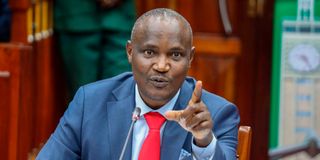
John Mbadi the Cabinet Secretary for National Treasury and Economic Planning.
Yet, the public’s patience is thin. Healthcare, education and water top their list—debt repayment does not. They, after all, pay people like Mr Mbadi to cure that headache.
Mr Mbadi faces his own challenge—a budget that spares Kenyans’ wallets after last year’s tax fiasco. He has promised a “near-zero reduction” in take-home pay, a nod to a public battered by inflation and hardship.
“My school is not that of over-taxing,” Mr Mbadi said last week.
Enter Okiya Omtatah. The Busia senator has lodged a case that seeks to pin accountability on Mr Kenyatta and his team for Sh4.6 trillion borrowed between 2013 and 2022.
In court papers, Mr Omtatah labels the borrowing spree “odious” and alleges that the funds—Eurobonds included—bypassed constitutional oversight by landing in offshore accounts.
“The government exposed the money to misuse,” he says in court papers filed last week, citing violations of the Public Finance Management Act. It is a bold gambit, unlikely to undo the debt but sure to stoke public anger.
Kenya’s tab rocketed from Sh2.37 trillion in 2014 to Sh8.57 trillion by 2022. Omtatah wants answers—and culprits to hang for their alleged crimes.
President Ruto’s recent China trip yielded a lifeline—or a leash. He secured a $1.5 billion (Sh194.2 billion) package, largely for infrastructure, including extending the SGR to Uganda to unlock its trade potential.
Chinese investors committed $500 million (Sh64.75 billion) to manufacturing, aiming to boost jobs and exports, easing forex pressures.
Yet, these “goodies” are a double-edged sword. For President Ruto, it is a high-wire act. Temporary relief risks long-term entanglement, testing his promise to borrow wisely while keeping Kenya afloat.
As President Ruto crafts his next budget, the clock ticks. Debts mature, lenders watch, and Kenyans wait. Mr Mbadi’s pledge to ease the debt burden while delivering services is a tall order.
“We need to lower our debt so we can provide services. We have started on that journey,” the Treasury CS said.
Passing this year’s budget is Ruto’s defining test. Last year’s collapse, fuelled by protests and political chaos, looms as a warning. Success demands navigating public trust, Parliamentary votes, economic pressures and debt deadlines.
For public trust, President Ruto may need to restore faith after 2024 missteps with transparent dialogue. In Parliament, he will need to ward off any opposition to proposals in the 2025/2026 budget, even as economic variables like inflation, unemployment and poverty pile onto the equation.
All that, as debt deadlines run after Kenya’s coffers, threatening to wipe out funds that would have otherwise gone into development.
Mr Mbadi, the new sheriff in town, has insisted on responsible borrowing.
“No economy grows without borrowing. If you live within your means, you die within your means,” Mr Mbadi said in a past interview.
Yet, with Sh11 trillion hanging over Kenya, the pain of debt is a daily reality. For President Ruto, this budget isn’t just a fiscal plan – it is a survival test.

